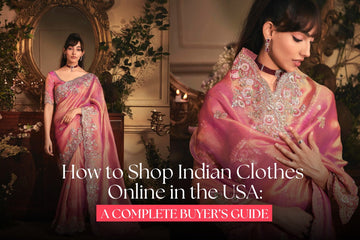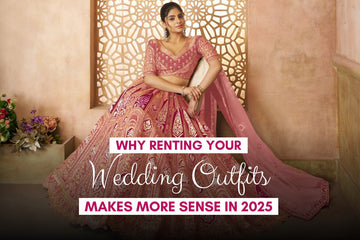Indian weddings are quite breathtaking. To stand out at the event, it is critical to dress appropriately. Indian weddings are family- and friend-centred celebrations of love. Indian wedding dresses have the most gorgeous attire, exuding elegance and nobility. When choosing a dress, colour is one of the most significant elements to consider. Indian weddings are always colourful, so choose a brightly coloured dress with matching accessories to shine. Given the fabrics, style, and accessories, it might be difficult to choose the correct outfit. In this article, we will look at how to find the appropriate outfit for an Indian wedding.
Understanding Indian wedding dress codes
Indian weddings stretch for several days and include several functions. Each function has a unique style and dress to wear. To select the appropriate Indian wedding dress, review the type of the occasion, the formality level, and its associated traditions.
Indian wedding dresses for bride
Indian wedding outfits for brides are a key attraction. Brides frequently wear lehengas, sarees, or anarkali outfits to the event. It is mostly driven by regional and cultural preferences. Let's talk about the highlights of several outfits.
-
Lehenga choli
Lehenga choli is a classic preference of the bride. It is one of the most common attires of brides as well as wedding guests, irrespective of locality and tradition. They range from classic monochromatic embroidered styles to Indowestern lehenga styles. Lehenga choli is a two-piece designer set often worn along with a dupatta wrapped in different styles. Lehenga matches every body shape and age, making it a versatile option for weddings.
Types of Lehenga Choli Across India
There are different types of Lehengas available in India. Each has its own attractions and elegance.
-
A-Line Lehenga
An A-line lehenga is a clean, elegant model and has a skirt that gradually flares from the waist. It is a style suitable for every body shape due to its balanced and flattering silhouette. An A-line lehenga offers volume without being overly dramatic. The best fabrics to be used are georgette, chiffon, or crepe for a flowy wedding guest wear look. Silk or velvet fabrics add richness for bridal wear.
-
Circular Lehenga
A circular lehenga is the perfect option, offering maximum flare and volume. They have multiple pleats, and with the right accessories, brides make a grand statement. They have the right fitting around the waist. They often have different combinations of embroidery, zari, sequins, and mirror work to enhance the luxury of the lehenga. The borders are often heavily embellished to highlight the circular flare.
-
Sharara Lehenga
The sharara lehenga has wide-leg pants instead of a skirt. It is not a common option. However, they add a different style to the event. They match body types like pear-shaped and hourglass-shaped bodies. It's a great choice for events like Mehendi or Sangeet.
2. Saree
A saree has been a traditional women's dress for generations. It is a perfect example of beauty and grace. The saree is a long, unstitched fabric draped around the body in various styles. It is traditional clothing, particularly in the southern Indian region. They vary in style according to the culture and traditions of the various states. It is ideal for all body shapes. To accentuate the feminine beauty, a saree is the best option.
A saree is typically 5-9 yards in length, leaving enough fabric to drape around the body. It is an attire suitable for brides and guests as well. They are of different fabrics like silk, cotton, chiffon, georgette, crepe, or organza. More luxurious and heavier fabrics like Banarasi silk or Kanjeevaram are ideal fabrics for weddings.
Types of Sarees Across India
Banarasi Saree (Uttar Pradesh):
-
Luxurious silk saree with heavy thread work.
-
It is ideal for weddings and other grand festivities.
Kanjeevaram Saree (Tamil Nadu):
-
It is known for its bright colours and ethnic works.
-
They are often adorned with temple motifs.
Paithani Saree (Maharashtra):
-
Patterns like the peacock motifs are the speciality of the Paithani saree.
-
They are perfect for festive occasions.
Bandhani Saree (Rajasthan/Gujarat):
-
Popular for their tie-dye techniques
-
They have wide varieties of vibrant patterns.
Chanderi Saree (Madhya Pradesh):
-
Lightweight and flowy saree
-
Made of sheer fabrics and has traditional motifs.
Sambalpuri Saree (Odisha):
-
Handwoven saree with unique geometric or floral designs.
-
Expensive due to its art value.
3. Anarkali suit
A classic outfit with a long, flowing dress called an Anarkali suit. It gives the skirt volume and fits the body well. It is a common attire choice for formal occasions like weddings. The Mughal Empire is where this ensemble originated. The attire is embellished with various zari work, embroidery, or ornaments to add richness to the occasion. Fabrics like satin, chiffon, and georgette are used to make them. These materials give the skirt a flowing appearance. Typically, it consists of a long gown, pants, and a dupatta.
Types of Anarkali Suit Across India
-
Traditional Anarkali Suit
Long, flowing garments with a lot of decorations are characteristics of traditional anarkali suits. Luxurious materials like silk, georgette, or chiffon are used, and the clothing is embellished with zari, beading, or intricate embroidery.
-
Anarkali Gown
Anarkali gowns are a blend of anarkali and western gowns. Its style combines classic and modern elements. This is used for modern weddings and semi-formal gatherings.
-
Short Anarkali
As the anime suggests, a short anarkali has a shorter length. It extends up to the knees or mid-calf. It is a good option for day events. It is not a popular option for weddings but can be used in functions like haldi, sangeet, etc. Short anarkalis are paired with leggings and palazzos for a trendy look.
-
Double Layered Anarkali
A double-layered anarkali has two layers of fabric, where the top layer is sheer fabric and the bottom layer is more solid. Due to this double layering, this anarkali provides depth and definition to the outfit. A double-layered anarkali is a popular option for evening events.
Tips for Selecting Wedding Accessories
To complete the Indian wedding look, accessories are just as important as the attire. Jewellery, purses, and shoes are examples of wedding accessories. Each of these should be chosen to complement the ensemble.
-
Jewellery: Opt for an exclusive traditional piece or contemporary jewellery based on your outfit. Gold jewellery is an evergreen option for Indian weddings. However, diamonds and coloured stones give a modern touch to the outfit. Necklaces, bangles, and earrings are all some of the most popular wedding accessories for brides and guests alike.
-
Footwear: One can opt for more comfortable and stylish footwear that matches your outfit. Traditional footwear like juttis, mojris, or embellished sandals can be a perfect option for footwear. Heels or wedges can also be a fair option. They provide a more contemporary look.
-
Handbags: Handbags are an addition to enhance the overall look of the outfit. Always choose a small bag with minimal pattern or embellishment to balance out the accessories, makeup, jewelry and the outfit.
By following these, one can make sure they have a perfect subtle look for Indian weddings.
Frequently Asked Questions
-
How Much Does an Indian Wedding Dress Cost?
Various factors like the fabric, embroidery work and designer influences the cost of an Indian wedding dress. The budget-friendly dresses start from INR 10,000 while the high-end designer options range from INR 1,00,000 up to INR 10,00,000. Additional amount applies in case of customizations. If high end fabrics are used, the cost would surge accordingly.
-
What should I wear to an Indian wedding as a guest?
As a wedding guest, one can opt for attires like lehenga, saree, salwar kameez, or an Indo-western gown. It should be noted that plain white or black outfits should be avoided for festivities.
-
Do I need to wear jewelry to an Indian wedding?
Jewelry is an important part to complete the Indian wedding look. One can opt for traditional gold, stone work or diamond jewelry that compliments the outfit. Even contrasting colour jewelry can be worn to give a celebrity look. It should be noted that the accessories should not overweigh the outfit. Try to keep the accessories minimal and lighter.
Conclusion
Dressing up for an Indian wedding demands careful consideration and an understanding of the traditions and practices underlying the clothing. It can be difficult to choose the ideal outfit, whether you are the bride or the guest. However, it would be a simple process if you followed the suggestions that are made in the article. Clothing selection must be based on body type, comfort level, and complementary style. What matters most is that you feel comfortable and confident in the garment. Since every Indian region has unique wedding dress styles that are a reflection of its own culture, the possibilities are virtually limitless. To improve your overall appearance, make sure you accessorise appropriately. By using the advice and strategies in this article, you can shine in the event.
-


















